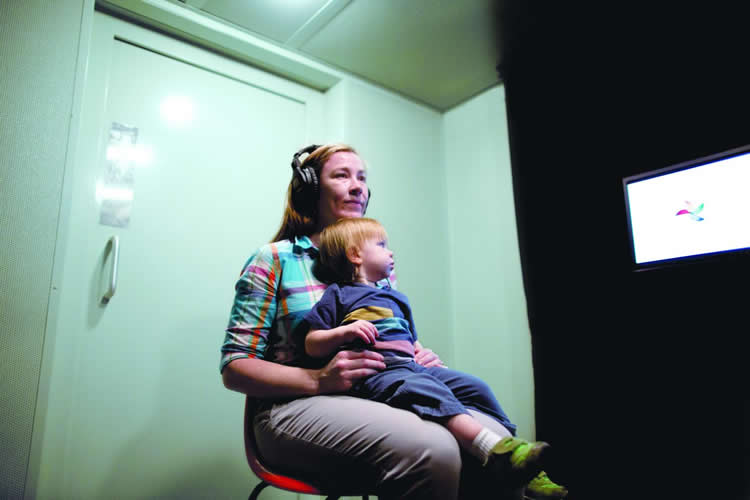Summary: A new study considers how lexical tones can affect an infant’s ability to associated words with objects.
Source: University of Tennessee.
Infants may be more sensitive to non-native speech sounds than previously thought, according to a study published in the Journal of Memory and Language. The findings shed light on the way babies begin to understand language.
The study, coauthored by Jessica Hay, an associate professor in the University of Tennessee, Knoxville’s Department of Psychology, and Ryan Cannistraci, a PhD student in experimental psychology, looks at how lexical tones can affect an infant’s ability to associate words with objects.
Lexical tone is the manipulation of a word’s pitch contour. Although English words do not make use of pitch contours within words to convey meaning, many languages–such as Mandarin Chinese, Cantonese, and Thai–do.
For example, by changing the pitch contour, the Mandarin word ma can mean either “mother,” “horse,” “hemp,” or “to scold.”
What differentiates Hay and Cannistraci’s study from others in the field of infant language learning is its focus on these non-English sound structures.
“Most research on early word learning has focused on what is referred to as intonation languages, where pitch changes are used at the phrase level but not to mark changes in word meaning,” Hay said. “However, over half of the world’s languages use pitch contours to communicate meaning.”
The researchers based their experiments on a cognitive skill called task switching–the ability to unconsciously shift attention between different tasks. The research involved presenting 14-month-old subjects with two novel objects paired with a novel pseudoword. The babies had English as their primary household language.
Once the infant was used to the association between the object-label pairs they underwent two sets of trials. In the “same” trials, infants were presented with objects along with their correct label. In the “switch” trials, the labels were reversed. By measuring average attention for both trial types, researchers were able to gauge whether the subjects had truly learned the object-label association. It may seem intuitive that the infants would have an easier time discerning between two objects when the labels differ greatly in tone, but this is not always the case.
In fact, the researchers found that the babies were able to learn the association between an object and its label more easily when they heard a sound with a high-pitch contour, just as babies that have Chinese as a primary household language would hear.

“We think it may be the case that English-learning infants are able to learn from the rising pitch contour in our experiment because they hear rising pitch contours in their everyday life,” Cannistraci said. “In English, rising pitch contours are prevalent in infant-directed speech, and are also often used to solicit attention and to mark questions.”
The experiments pave the way for a more inclusive approach to understanding how language is learned.
“In order to be able to generalize what we know about how children learn languages, it is important to study all sorts of different languages,” Hay said. “By incorporating non-native lexical tones into our studies, we have learned that infants are able to apply what they know about their own language when learning words in a new language. This suggests that infants are motivated to learn language and will use any potentially relevant information available to them.”
Source: Andrea Schneibel – University of Tennessee
Publisher: Organized by NeuroscienceNews.com.
Image Source: NeuroscienceNews.com image is credited to Daryl Johnson/University of Tennessee..
Original Research: Abstract for “Mapping non-native pitch contours to meaning: Perceptual and experiential factors” by Jessica F. Hay, Ryan A.,Cannistraci, and Qian Zhao in Journal of Memory and Language. Published February 20 2019.
doi:10.1016/j.jml.2018.12.004
[cbtabs][cbtab title=”MLA”]University of Tennessee”Mandarin Chinese Could Help Us Understand How Infants Learn English.” NeuroscienceNews. NeuroscienceNews, 20 February 2019.
<https://neurosciencenews.com/mandarin-english-learning-10782/>.[/cbtab][cbtab title=”APA”]University of Tennessee(2019, February 20). Mandarin Chinese Could Help Us Understand How Infants Learn English. NeuroscienceNews. Retrieved February 20, 2019 from https://neurosciencenews.com/mandarin-english-learning-10782/[/cbtab][cbtab title=”Chicago”]University of Tennessee”Mandarin Chinese Could Help Us Understand How Infants Learn English.” https://neurosciencenews.com/mandarin-english-learning-10782/ (accessed February 20, 2019).[/cbtab][/cbtabs]
Abstract
Mapping non-native pitch contours to meaning: Perceptual and experiential factors
Infants show interesting patterns of flexibility and constraint early in word learning. Here, we explore perceptual and experiential factors that drive associative learning of labels that differ in pitch contour. Contrary to the salience hypothesis proposed in Experiment 1, English-learning 14-month-olds failed to map acoustically distinctive level and dipping labels to novel referents, even though they discriminated the labels when no potential referents were present. Conversely, infants readily mapped the less distinctive rising and dipping labels. In Experiment 2, we found that the degree of pitch variation in labels also does not account for learning. Instead, English-learning infants only learned if one of the labels had a rising pitch contour. We argue that experience with hearing and/or producing native language prosody may lead infants to initially over-interpret the role rising pitch plays in differentiating words. Together, our findings suggest that multiple factors contribute to whether specific acoustic forms will function as candidate object labels.







